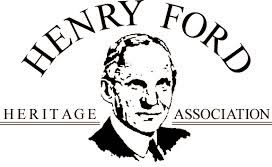The Illustrious Vagabonds
The Illustrious Vagabonds
1914

On an ancient waterwheel in West Virginia in 1918,the Four Vagabonds pose for a cameraman. Left to right are Harvey Firestone, Henry Ford, John Burroughs and Thomas A. Edison.
For several years before and after 1920, Henry Ford, Thomas Edison, Harvey Firestone, and John Burroughs participated in a series of motor camping caravans, which have been described as the first notable linking of the automobile with out-door recreation.
The idea for the camping trips seems to have germinated in a trip by the Fords and the Edisons to the Florida Everglades in 1914. It took firm root in California in 1915, when Ford, Firestone, and Edison motored from near Los Angeles to San Diego.
The group so much enjoyed the freedom and fun of motoring that Edison proposed similar "gypsy" trips in future summers. All agreed.
1918
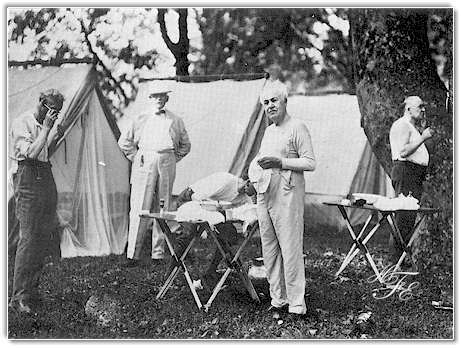
Shaving time on a summer morning in 1921 in the Great Smokies. Left to right: Henry Ford, Bishop William F. Anderson, Harvey Firestone (stooping). Thomas A. Edison and President Warren G. Harding. Ford seems to be managing without a mirror, perhaps in deference to the President who is making use of one. Bishop Anderson, fully dressed, apparently was an early riser. Firestone, Edison and the President display a variegated assortment of undershirts.
Ford, as it turned out, was too busy to join the 1916 expedition, which included the naturalist John Burroughs. But the auto king joined the 1918 outing to the Great Smokies, and at once became the dominant spirit of this and later excursions.The 1918 "Vagabonds" (as the campers styled themselves) were Edison, Firestone and his son, Harvey, Jr., Ford, Burroughs, Professor R. J. DeLoach, an expert in plant pathology, and for a time Edward N. Hurley of the United States Shipping Board. They moved along in six cars-two Packards for riding, two Model Ts, and two Ford trucks-plus seven drivers and helpers.
The 1918 trip covered a lot of ground, for the vagabonds drove from Pennsylvania down through West Virginia to Tennessee, and then swung over to North Carolina, Virginia, and Maryland, This trip set a pattern for those to follow. In 1919 the party swung through northern New York, Vermont, and New Hampshire. Along the way the group visited a power site Ford had purchased at Green Island on the Hudson River. A camping trip was omitted in 1920, although the group had a fall outing at Yama Farms, New York. Then the wives demanded a share in the adventure, and in 1921 a journey through Maryland and Pennsylvania saw Mrs. Edison, Mrs. Ford, Mrs. Firestone, Mrs. Harvey Firestone, Jr., and Mrs. W. F. Anderson (wife of Methodist Bishop William F. Anderson) with the party, as well as President Harding. Mrs. Harding had been invited but could not go.
1923
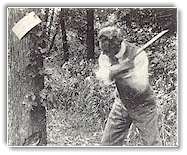
The picture is dulled by age, but the action is lively as Henry Ford swings from the left on a tree destined to provide fuel for the vagabonds' campfire.
In 1923 the party visited President Coolidge in Massachusetts, and in late April, 1924, on a journey across the upper peninsula of Michigan, Ford acted as engineer and Firestone as fireman for a train which carried the Fords, Edisons, Fire stones, and Edsel Fords to various Ford properties - Iron Mountain, Sidnaw, and L ' Anse among them. Later in the year all assembled as Ford's guests at the Wayside Inn, in Massachusetts, and the men called upon Coolidge in Plymouth, Vermont, who made Ford a gift of a four gallon maple sap bucket, fashioned about 1780 by one of his ancestors.1923

Henry Ford tries his hand at cooking flapjacks. At the rear are two of the special trucks which accompanied the campers.
The group, as Burroughs noted in his diary, craved direct contact with nature, and "cheerfully endure wet, cold, smoke, mosquitoes, black flies, and sleepless nights, just to touch naked reality once more." But the party did not exactly rough it. No one slept on a bed of boughs or subsisted on fish caught in the stream. Separate sleeping tents, each with the occupant's name on it, were provided, Of the army type, about ten feet square, the tents had mosquito netting flaps sewn in the front and were suspended from what is now called by the camping industry "the modern outside frame system." A dining tent about twenty feet square, set up convenient to the sleeping tents, was the fore- runner of the "additional room" tent found today.One of the most useful pieces of equipment -- and one which would be welcomed by many camping families today -- was a large, circular dining table, nine feet in diameter, and surmounted by a large Lazy Susan which the diners could rotate to reach any of the many dishes served at each camp meal. Large as it was, this table folded into a tiny package that could be slid into a crevice of the baggage truck.
The Lazy Susan can be seen today at the Henry Ford Museum. The signatures of President Harding and other members of the party have been preserved under clear plaques, and the table is over-looked by a huge wall photo mural of the party scene.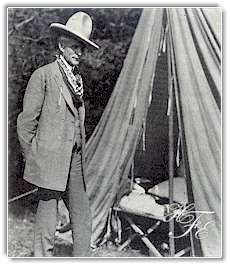
Henry Ford in cowboy hat and neckerchief, poses outside his tent.
The wood and canvas camp chairs (also displayed in the Museum) were of a design known as the modern "sling, or butterfly, type," but with a folding feature allowing them to be stowed in a small space. New-fangled gasoline stoves were taken along, but the preference of all was an old-fashioned wood fire, and so the campers devised a grill made of two iron bars with hooks to hold the cooking pots.A basic supply of food staples was carried in the kitchen truck and the steaks, ham, bacon, vegetables, and the fresh eggs, milk, and cream favored by the group were bought along the way from farmers. Frequently local people dropped by the camp with gifts of apples or watermelons. An employee regularly returned to town for Ford's special bread. Noonday meals and generous rest periods were held at pleasant wayside areas that were early counterparts of today's roadside table parks. The 1922 Lincoln kitchen truck used on the safaris is currently on display in the garage at Fair Lane while a White truck that carried tents and equipment, is on display at the Henry Ford Museum.
Records of the various trips reveal how the campers spent their time. Burroughs frequently would have his tent placed apart from the rest so he could meander, in linen duster and with long white beard flowing, among the local plants and creatures. When the party came upon small industries, Firestone would speculate on how modern methods could improve their production. Ford and Edison, if he wasn't reading in the front seat of the touring car, would walk along a stream edge, conjecturing as to its electricity-producing possibilities. At one mountain lumber camp the group clambered aboard a logging locomotive for a ride with Ford at the throttle.
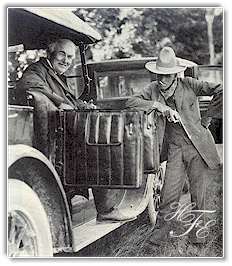
Henry Ford clowns while Thomas Edison beams during a rest stop on a camping trip. This picture is probably the only one
ever taken of Ford with a cigarette. The auto king and Edison both abhorred the use of "little white slavers," as they called cigarettes.Ford chopped wood for the fires, around which the party sat after supper . The auto king also displayed his ingenuity as a handyman. At a garage in Connellsville, Pennsylvania, where an unscheduled stop had to be made for repairs on a Packard, the manufacturer fixed a radiator and fan after local mechanics had advised that it couldn't be done. The large sidewalk audience of townspeople was impressed! Edison often gathered rocks, breaking them with a hammer to ponder the possibility of extracting the valuable minerals they contained. Ford and Edison bathed in creeks without hesitancy, but Firestone showed a preference for washing at a hotel whenever one was near enough to permit it.The Vagabonds were accompanied by newsmen and photographers who reported each man's every move and hung on his every utterance. Almost all of the newspapers in the country reported and theaters showed Ford, Edison, and Burroughs engaging in high-kicking, stair-jumping, sprinting, tree-chopping, and tree-climbing contests. On one occasion, Edison, at age 71, kicked a cigar off a mantle in a hotel lobby three straight times, Ford, 55, once, with Burroughs, 81 , unable to connect.

Gathered around their Lazy Susan camp table near Hagerstown, Maryland in 1921, clockwise from just left of the tent pole, (some partially hidden) are William F. Anderson, Methodist bishop of Ohio; Harvey Firestone Sr.; George B. Christian. Jr.; Mrs. Thomas A. Edison; Thomas Edison; Mrs. Henry Ford; President Harding; Mrs. Firestone, Sr.; Henry Ford; Mrs. Anderson; Edsel B. Ford; Mrs. Firestone, Jr.; Harvey Firestone, Jr. and Russell A. Firestone.
In a stair-jumping contest, Ford bounced up 10 steps in two hops; Edison needed three steps, while Burroughs, still game, lost his balance and had to be rescued by onlookers. But Burroughs was the champion tree cutter-- felling a tree in four minutes flat, a few seconds ahead of Ford.As the group moved along, headlines blazoned, "Henry Ford Demonstrates He's Not Afraid of Work; Repairs His Damaged Car," "Millions of Dollars worth of Brains Off on a Vacation," "Genius to Sleep Under Stars," and "Kings of Industry and Inventor Paid City Visit." Columns were filled with stories and trivia about the famous quartet. The Chicago Tribune, still smarting from its defense of the libel suit which Ford had successfully brought against it, was perhaps the only paper in the country to take issue with the United Press' news judgment in sending the following comments over the wire in 1921:
- "Do you think Mr. Harding can put this disarmament program over?" Ford is said to have asked Edison.
"I think it will depend upon money. If Harding can keep them from getting the money he'll succeed with his program."
"The common people around the world will back him on that," interposed Mr. Ford-the man who envisioned the peace ship.
Mr. Firestone contributed his fear that Mr. Harding was going to meet subtle op- position, at which Mr. Edison said slowly, "The motives of men are unfathomable," and Mr. Ford brought the curtain down on this memorable occasion with, "Humph, you said it."
According to Burroughs, Edison was the "intellectual" among the travelers, although Burroughs disagreed with the inventor when he claimed Evangeline and Les Miserables were the greatest works of poetry and fiction of his time and again when he proposed that Shakespeare be translated into "plain English."
1924
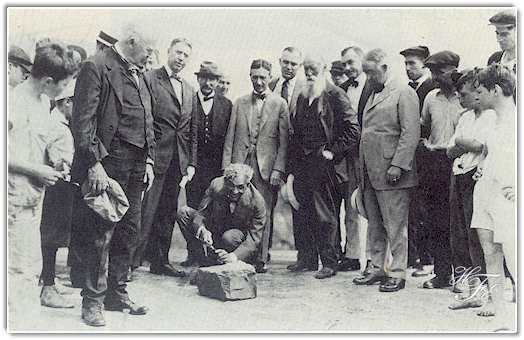
This photo was taken on August 5, 1919 during the vagabonds' camping trip, and shows Henry Ford carving his initials on the stone which became the cornerstone of his manufacturing plant at Green Island, New York, which to this day is the key plant of Ford's Engine and Foundry Division. Others in the picture include Thomas A. Edison, holding cap; Harvey Firestone, standing behind Mr. Ford; John Burroughs, the bearded naturalist and writer, on Mr. Firestone's left; Cornelius Burns, then mayor of Troy, N.Y ., in which the plant is located, on Mr. Firestone's left; and James R. Watt, then mayor of Albany, standing between Messrs. Edison and Ford. Photo from Ford's Green Island Plant.
The last camping trip took place in 1924. "The trips were good fun," Ford wrote in his autobiography, My Life and Work, "except that they began to attract too much attention." Ford's statement, however, belied his interest in the publicity received by the group. In 1918, for example, he requested that a typewritten report, containing verbatim news stories from all papers in the six states through which the party traveled, be prepared for his perusal. Similarly, it is difficult to believe that many of the contests and hijinks in which the aging vagabonds participated were not staged for the benefit of the nearby reporters and photographers (Edison, little less than Ford, was appreciative of publicity and a top-notch publicist). As Charles E. Sorensen wrote in My Forty Years with Ford: "With squads of news writers and platoons of cameramen to report and film the posed nature studies of the four eminent campers, these well- equipped excursions...were as private and secluded as a Hollywood opening, and Ford appreciated the publicity."
The trips also had become a formidable undertaking by 1924, what with the wives of the men coming along. The introduction of the women conventionalized the expeditions; they could not be as informal as they had been without them. Mrs. Ford took along a cook, Mrs. Edison a personal maid and chauffeur, and the Firestones a butler and a driver. Harvey Firestone, Jr. also took along riding horses; Ford didn't care for that. In addition, by 1924, the three surviving members of the original group (Burroughs had died in 1921) were older and, in the case of Ford and Firestone, busier .
Although the vagabonds camped no more, the publicity surrounding their expeditions acquainted millions of people with the pleasures of motor camping and undoubtedly inspired many auto owners to follow their example. The Vagabonds thus were the avant-garde of the countless vacationers, trailers in tow, who annually take to the highways, and of the huge recreational industry which serves them.
